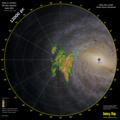Zone of Avoidance
The Zone of Avoidance (ZOA) is the area of the night sky that is obscured by our own galaxy, the Milky Way.
Dust and stars in the plane of the Milky Way (the galactic plane) block our view of about 20% of the sky at visible wavelengths. As a result, optical galaxy catalogues are usually very incomplete close to the galactic plane.
Modern developments
In more recent years, many projects have attempted to bridge the gap in our knowledge caused by the Zone of Avoidance. However, the effects of the Zone drops at longer wavelengths, such as the infrared, and the Milky Way is effectively transparent at radio wavelengths. Surveys in the infrared have given us a more complete picture of the extragalactic sky. Indeed, two very large nearby galaxies, Maffei 1 and Maffei 2, were discovered in the Zone of Avoidance by Paolo Maffei by their infrared emission in 1968. Even so, about 10% of the sky remains difficult to survey because extragalactic objects (for example, distant galaxies) can be confused with stars in the Milky Way.
Projects to survey the Zone of Avoidance at radio wavelengths have detected many galaxies that could not be detected in the infrared. Examples of galaxies detected from their HI emission include Dwingeloo 1 and Dwingeloo 2.
Important superclusters of galaxies lying hidden or partly hidden by ZOA are The Great Attractor and the Norma Cluster.
Zone Of Avoidance Media
The limits of observation as visualized by the Milky Way's star density map. Source: Gaia spacecraft's 2021 data release
References
- Kraan-Korteweg, Renée C.; Lahav, Ofer (May 24, 2000). "The Universe behind the Milky Way". The Astronomy and Astrophysics Review. 10 (3): 211–261. arXiv:astro-ph/0005501. Bibcode:2000A&ARv..10..211K. doi:10.1007/s001590000011. S2CID 14760994.
- R. C., Kraan-Korteweg; L. Staveley-Smith, J. Donley, P.A. Henning (November 5, 2003). "The Universe behind the Southern Milky Way". International Astronomical Union.

